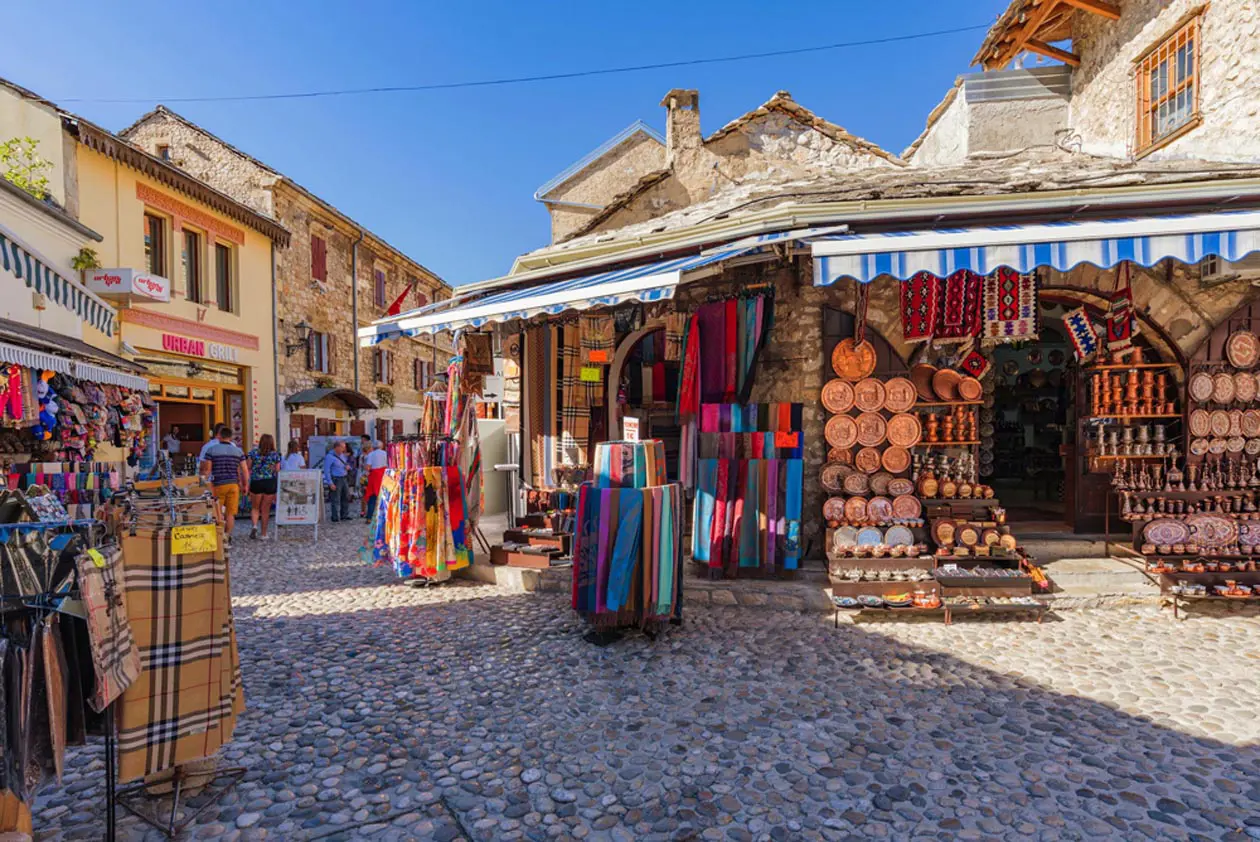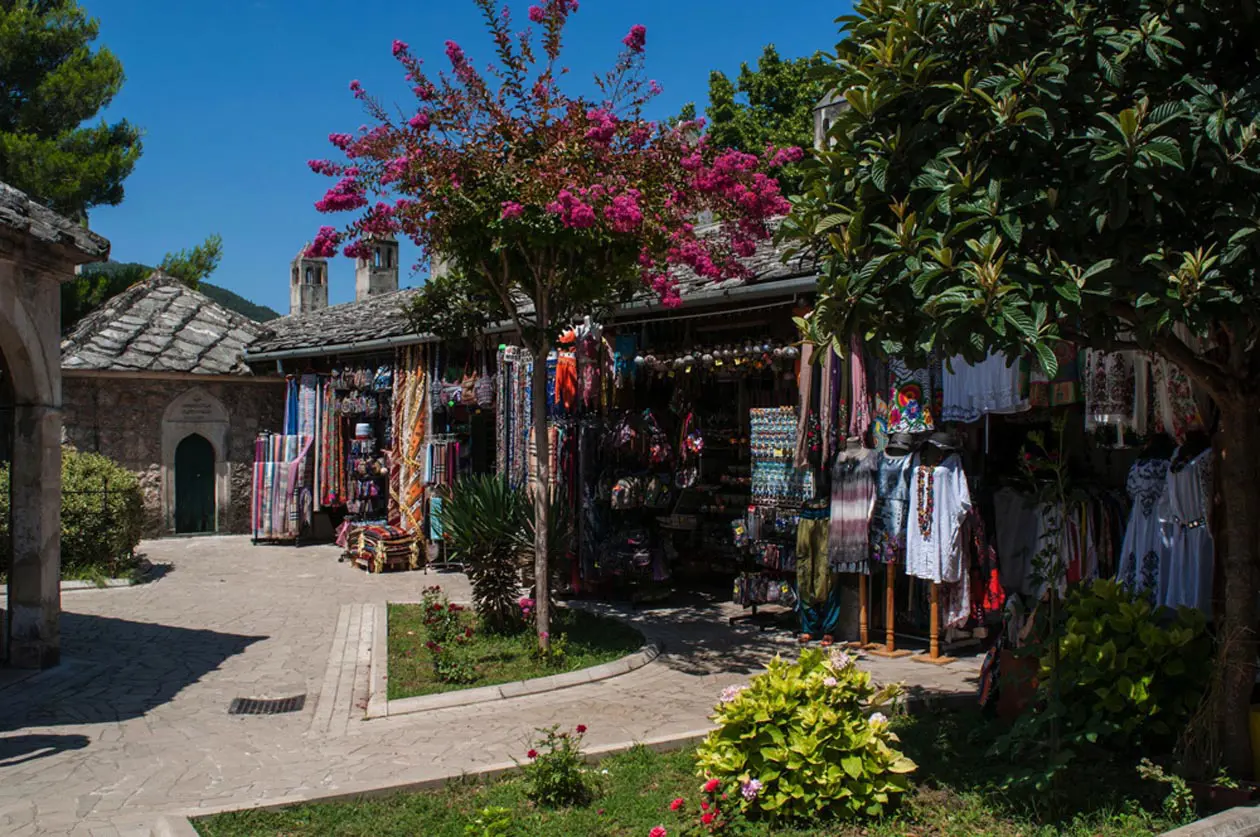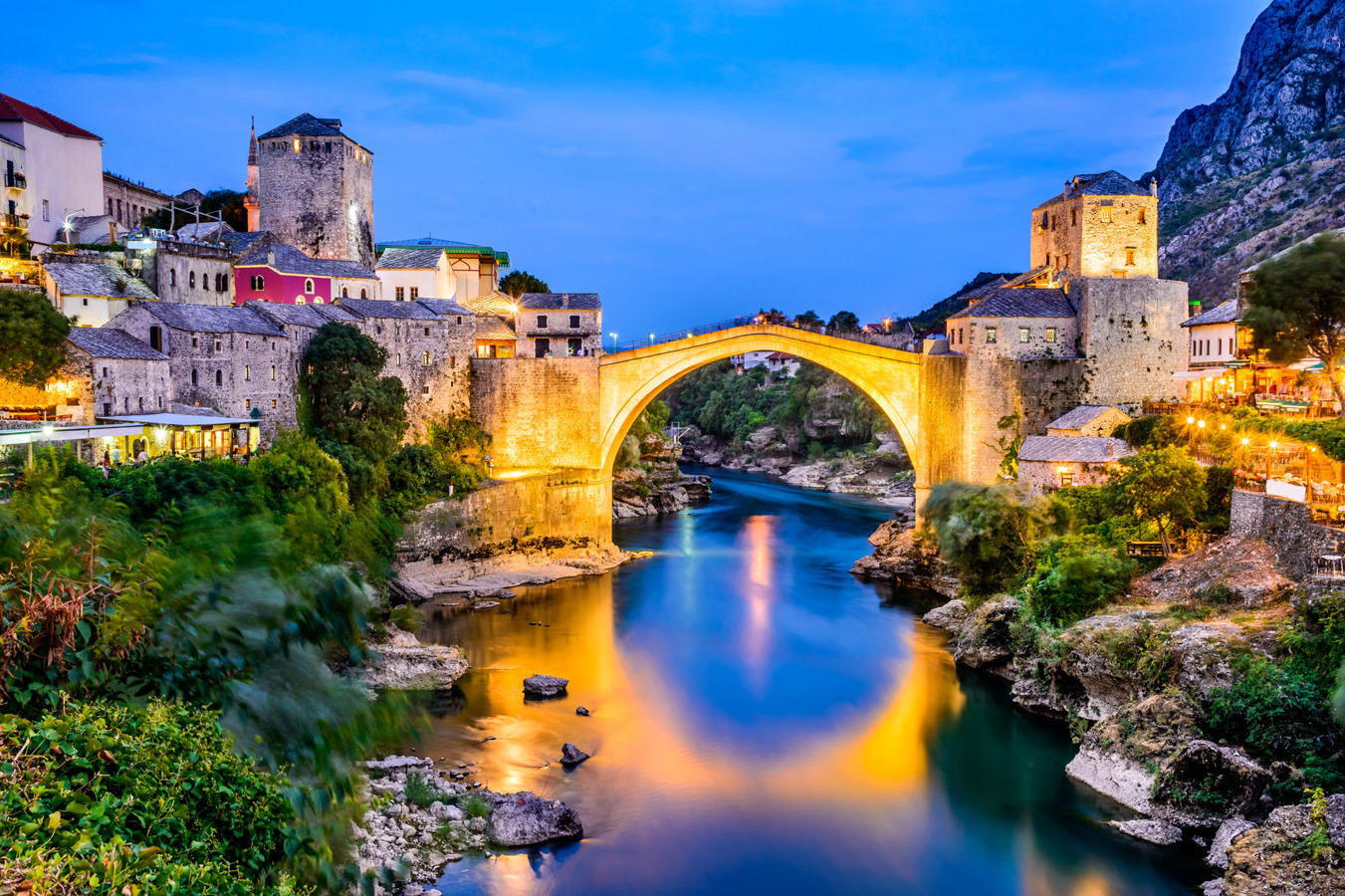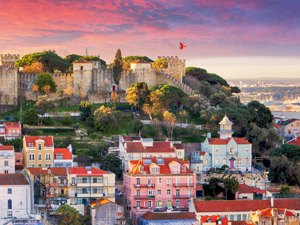The city where east and west meet
Built alongside the River Narenta, the capital of Herzegovina is known by all thanks to the image of its beautiful “Old Bridge" (Stari Most), which was destroyed by bombing during the recent Yugoslavian war. The name of Mostar is linked to this bridge; it derives, in fact, directly from the term “mostari” or “keepers of the bridge“, precisely for its characteristic of being developed on the two banks of the river in such a strategic position that it became a wealthy city in spite of the fact that the territory of Herzegovina was rather poor and barren. The site on which it stands has always represented the ideal meeting place between eastern and western Europe.

City landscape of Mostar. Copyright © Sisterscom.com, Shutterstock
The Stari Most is the heart and symbol of the city and was built in 1565 by the architect Hajrudin during the rule of Suleiman the Magnificent. The legacy of Ottoman rule is evident in much of the Moorish architecture found in Mostar and by the powerful presence of the Muslim population, who before the conflict of the nineties lived peacefully together with fellow Christians. After Ottoman rule, it was the turn of Austrian-Hungarian domination over the region, a period which also left behind beautiful examples of architecture.
 Stari Most in Mostar. Copyright © Sisterscom.com, Shutterstock
Stari Most in Mostar. Copyright © Sisterscom.com, Shutterstock Today Mostar is a multi-ethnic city where four different religious faiths live together – not just Christians and Muslims, but also Orthodox Christians and Jews.
The old town of Mostar
Strolling along the narrow streets of the old town, a UNESCO World Heritage Site, you can see witnesses of this multiculturalism; alongside the Christian and Orthodox churches are splendid mosques, baths and noble palaces.
 Mostar old town. Copyright © Sisterscom.com, Shutterstock
Mostar old town. Copyright © Sisterscom.com, ShutterstockThe bridges of Mostar
But it is the bridges that are the characteristic feature of Mostar, beginning with the oldest: ”Kriva Cuprija” or crooked bridge, a pretty bridge with unique arch which was built just before the largest and best known Stari Most bridge. The latter bridge, as many remember, was destroyed during the bombing of 1993, but the population faithfully reconstructed it using original building techniques and taking stone from the original quarry used for its previous construction. It was opened again in 2004 and each crossing is an emotional experience as one passes over the old point in which east and west symbolically met.
Moorish Buildings in Mostar
On the east bank of the river, we find the most beautiful Moorish buildings such as the Cejvan Cehaj Mosque and the Medresa (Islamic School). A short distance away, we come across the “Kujundziluk" the "old bazaar”, where the best local craft items can be found, in particular copper or bronze sculptures of the old bridge or the pomegranate, which is a symbol of Herzegovina.

The Mostar Kujundziluk. Copyright © Sisterscom.com, Shutterstock
If you wish to visit a mosque, slightly further ahead lies the Koski Mehmed, built in 1617 and open to visitors. Inside, the walls still have their original decorations and if you feel like confronting the narrow spiral stairway leading to the roof, the minaret is also open; from here you can enjoy a magnificent view over the city.
 Ottoman mosque in Mostar. Copyright © Sisterscom.com, Shutterstock
Ottoman mosque in Mostar. Copyright © Sisterscom.com, ShutterstockThe Ottoman architectures in Mostar
Right behind the corner of the mosque is the “Tepa” market, a crowded place since the time of the Ottomans; here you can find the best fresh local products. Continuing to the left is “Biscevica House”, the remains of an authentic Ottoman house from the seventeenth century. The house features a perfectly preserved living room with original period furniture and ornaments.
In this district you can also visit “Kajtazova House”, another Ottoman residence with separate areas for men and women; the Karadozbegova Mosque and the national monument, “Muslibegovic House”, residential complex of Ottoman nobles which is one of the best preserved and complete of the area. Even this eighteenth century house is divided into separate quarters for men and women – there are even different courtyards for the sexes: “selamluk” for the men and “haremluk” for the women. The house today, in addition to being a museum, is also place offering drinks and traditional sweets and houses a very beautiful hotel.

Mostar. Copyright © Sisterscom.com, Shutterstock
Besides the important examples left by the Ottoman Empire, no less interesting are the signs left by other cultures such as the Synagogue or the Stara Pravoslavna Crkva, the old Orthodox church built in pure Herzegovinian style. The multi-ethnic profile is completed by the Catholic churches and the Bishop’s House, built in Viennese style and witness to the fruitful period spent under the Austrian-Hungarian Empire.
Text by Lea Tocchi
Updated by Alisè Vitri
Avion Tourism Magazine
Photos for editorial use only: Sisterscom.com, Shutterstock
Copyright © Sisterscom.com All rights reserved
Copyright © Sisterscom.com All rights reserved
Tourism Board
www.hercegovina.ba
Partnership with Booking.com
Where to sleep in Mostar

Mostar Copyright © Sisterscom.com, Shutterstock
Mostar is a welcoming city and offers different possibilities for accommodation.
To find the ideal hotel and the best offers you can do a search for the stars but also for place of interest.
LANDMARKS
Hotels in tourist areas
where to go in mostar
Monuments in Mostar

Copyright © Sisterscom.com, Shutterstock
KOSKI MEHMED MOSQUE
This precious mosque was built in 1617 is open to visitors. This is the only mosque with the original wall paintings and decorations. For those willing to bear the dizzy spiral to the top, the minaret is also open to the public and is accessible from inside the mosque. The view speaks for itself!

Copyright © Sisterscom.com, Shutterstock
OLD BRIDGE
The Old Bridge of Mostar, built in 1566, is the symbol of the city and was included in the UNESCO World Heritage List in 2005. It is single arch structure connecting the left and right bank of the river Neretva. The Old Bridge offrers an very beautifull panorama of the river Neretva and the surrounding historical monuments of Mostar.

Copyright © Sisterscom.com, Shutterstock
KARADOZBEGOVA MOSQUE
The Karadozbegova Mosque is the most important and significant of sacred Islamic architecture in all of Herzegovina. Completed in 1557, its designer was Kodza Mimar Sinan, a great Ottoman architect. The mosque is open to visitors.

Copyright © Sisterscom.com, Shutterstock
MONASTERY IN ZITOMISLICI
The Monastery in Zitomislici, a few kilometres south of Mostar, is certainly worth visiting. It is located in the village of Zitomislici on the left bank of the Neretva River. This 1566 sacral is one of the most significant Herzegovinian Orthodox monasteries. It is open to visits.
KAJTAZOVA HOUSE
The Kajtazova House is another fine authentic Ottoman residential house with separate sections for men and women. High outer walls provided isolation and privacy to the inhabitants of the house. It is built out of stone and wood. It is open to visitors.
BISCEVICA HOUSE
The Biscevica House on Biscevica Street. This 17th century Ottoman house with particular pillars of over 5m long was built on the eastern banks of the Neretva. Inside there is a conversation or gathering room preserved in authentic Ottoman style. Throughout the house are original household objects and the courtyard is a fine example of the Ottoman style.
MUSLIBEGOVIC HOUSE
Muslibegovic House is located near the Karadoz - Bey’s Mosque and is one of the most representative monuments of the Ottoman residential architecture. The house was built in the 18th century, and the main residential quarter was reconstructed in 1872 in reference to the most monumental buildings in Istanbul.
Excursions in Mostar

Copyright © Sisterscom.com, Shutterstock
SARAJEVO
Sarajevo, the capital of Bosnia and Herzegovina, is a city full of charm and history that combines different cultures and traditions. Known as the "Jerusalem of Europe" for the coexistence of Muslims, Christians and Jews, Sarajevo offers a unique atmosphere thanks to its Ottoman and Austro-Hungarian architecture. Walking through the historic center of Baščaršija, among mosques, bazaars and traditional cafes, you can breathe the authentic Balkan soul. The city is surrounded by mountains, making it ideal for hiking and winter sports.

Copyright © Sisterscom.com, Shutterstock
MEDJUGORJE
Medjugorje, located in the heart of Bosnia and Herzegovina, is one of the most famous pilgrimage destinations in the world. Since 1981, when six young people reported having had visions of the Virgin Mary, this small village has become a place of spirituality and prayer. Here you can experience moments of meditation on the Apparition Hill and participate in religious services in the Church of St. James. In addition to spirituality, Medjugorje offers the opportunity to discover the surrounding natural beauty, such as the hills and vineyards that characterize the local landscape.
Partnership with GetYourGuide
Tours and excursions
News & Useful info
You might be interested in
Destinations found in the vicinity
Other destinations
Airports nearby Mostar


















